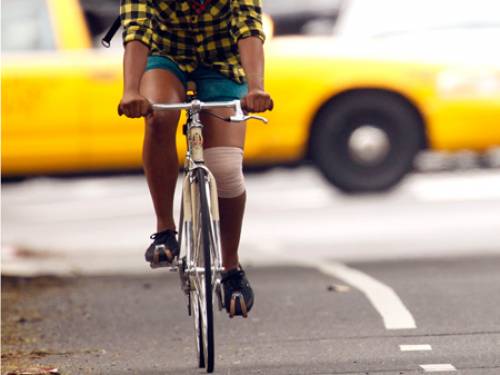This spring, Life of the Law had the exciting opportunity to work with students at Macalester College on writing about the law and their lives. This week, we’re sharing four of the blog posts that came out of this collaboration … and they’re really good. Here is today’s by student Nick Matzke.
Biking home from work in downtown Saint Paul during the summer of 2011, I collided with a car. It’s the sort of moment that, as a daily cycle commuter, you kind of expect will happen someday – there are so many close calls that it’s almost inevitable. You daydream about how you’ll skid out of the way and avoid the blow, or failing that, how you’ll get a raft of insurance money and maybe a few broken bones. Mine turned out to be a lot more pedestrian.
It was rush hour on a two-lane, one-way street. There was an accident up ahead by the freeway, in the left lane. The police had shut that lane down, and a long queue of drivers had formed. I was in the right lane, traveling with traffic, watching out for cars while rocking Sgt Pepper’s through my headphones. One woman, not seeing me, pulled right into my lane about 10 feet ahead. I saw it coming, jammed the brakes, but couldn’t quite stop in time. We collided.
My pedal hooked on the front right quarter panel, lifting and sending me maybe 10 feet forward, 6 or 7 to the right, although I somehow managed to land upright. The driver had stomped on the brakes, aghast, as soon as she saw me, and stopped just short of running me over a second time. We just kind of looked at each other, confused and terrified, then started to move with traffic.
Rolling slowly next to each other in the left lane, each argued our innocence. I offered the opinion that I had been clearly riding in the middle of a lane, following traffic law, and she offered hers: that I had been listening to music, and that I’d been going too fast and should have expected her to suddenly materialize in my lane. These claims struck me as hollow, me having been traveling well below the speed limit. And given that she’d pulled out directly in front of me, sound seemed rather superfluous. In the heat of the moment, you don’t do any of the things you know you’re supposed to do – call the police, file a report, exchange insurance information, all that. It’s a basic human characteristic to escape danger as quickly as possible.
It’s not a surprise then that this sort of story is all too common. There’s rarely much material damage to the car, so there’s no insurance to worry about, and as long as the pedestrian or cyclist isn’t obviously hurt, the flight instinct can take over.
As you might suspect, this creates somewhat of a problem for two reasons. The first is that cyclists, who usually don’t have insurance (not by choice: the option literally did not exist until the past few years, and even now is available in only a small handful of states, mostly on the West Coast), end up bearing the full brunt of the cost for vehicle repair or replacement after a crash, unless they wish to go head-to-head with an insurance giant. I was lucky; I only needed to bend a few parts straight.
The second aspect is that, in some ways, an unsafe situation that goes unreported is a situation that doesn’t exist at all; later, if a medical problem develops, there’s no record of the crash having happened, no way to have the driver’s insurance cover the cost. Since data drives government action, problem areas, intersections, and drivers can be overlooked simply because the problem goes unreported. The relatively small size of each individual incident makes this all the more likely – leading to a bias against the safety needs of cyclists. While individual fault will likely always reside with the cyclist or driver, providing a full, accurate dataset would place the legal onus for the collective problem directly on the government, rather than cyclists – as in, the government perhaps could be held legally liable through civil suits for its infrastructure failings in specific incidents.
The problem is compounded by the fact that many cyclists, especially those who aren’t riding around on $4,000 bikes, don’t have good health insurance, or maybe none at all. (These are the ones who use bikes for transportation, because they don’t have the money to spare for a car.) To charge these cyclists for a collision that may not have been their fault, and against which they literally cannot insure themselves, is a truly difficult burden to bear.
I’ve now broadly described the problem: that cyclists, uninsured and vulnerable, are unlikely to receive any recompense for their damaged bicycles in the case of minor accidents, and that this effect is self-perpetuating. Underreporting of this sort of incidents leads to a chronic lack of remedial action.
I’ve often regretted not having reported the collision, not because of any health or financial issues I had as a result – I only had to buy a single new part at $35 – but because I know a false perception of safety leads to inaction. The effort to make downtown Saint Paul, the place where the accident occurred, more pedestrian- and cycle-safe, needs all the proof it can get.









